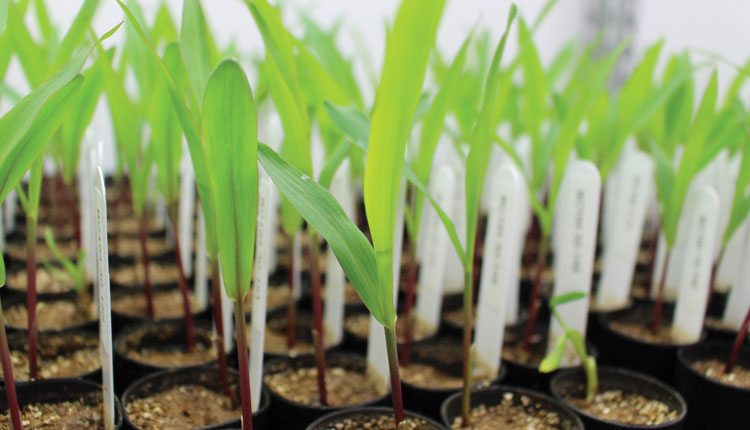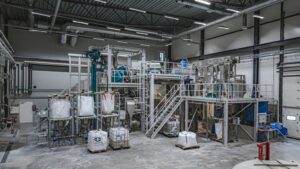Beneficial bacteria show promise for environment, bottom lines.
Farmers growing soybeans in the 1800s would notice that the crop did quite well in certain fields while struggling in others. Water, climate and other variables the same, they assumed there was something about the soil, and they were right.
Invisible to the naked eye and unbeknownst to those farmers, microbes — rhizobia in particular — were interacting with soybeans and significantly increasing the amount of nitrogen taken up from the soil by the plants. It’s one of the first instances of the agricultural world coming to understand the role microbes play in improving crops.
Farmers inoculated their own soil then. They would spread soil known to lead to nitrogen-fixing nodules from one field to other fields that did not lead to nodules on soybean roots, according to the book “History of Soybeans and Soyfoods in the United Kingdom and Ireland (1613-2015).”
“These are symbiotic relationships that have been going on since the beginning of time. The plant feeds the microbe, and the microbe is giving the plant some benefit,” says Marcus Meadows-Smith, chief executive officer at BioConsortia Inc., a research and development company based in Davis, California, that focuses on agricultural microbes.
What the agricultural world would come to understand is that these microbes — the bacteria and fungi present in abundance in soil — weren’t only responsible for the blights, mildews, cankers, leaf spots, rots and other diseases that farmers fight against come from microbes. They were always there in the soil doing unseen good, increasing root size, warding off pests and increasing plants’ abilities to pull needed nutrients from the soil.
“They’re all natural and native to the environment,” says Robert Shortell, vice president of global marketing at Houston-based Stoller Group, a company that produces products aimed at increasing crop yields. “We’re just starting to learn about these things. A lot of our newer molecular techniques allow us to identify the positive ones now.”
Estimates vary, but there are more microbes in one gram of soil, just a fraction of an ounce, than people on the planet, possibly several times more. And many of those billions of organism are in some way affecting the plants with which they come into contact.
“They all interact with the plant in some way. We’re looking at utilizing what nature gave us, identifying and singling out the microbes that have a benefit on certain crops in certain conditions,” says Colin Bletsky, vice president of the BioAg Team at Novozymes, a biotechnology company based in Denmark. “There are billions of opportunities.”
Those beneficial microbes, as we now understand, are a part of a complex mix that compete underground for survival much like crops and weeds compete on the surface. On the surface, farmers are constantly stacking the deck in favor of the crops by spraying herbicides and promoting faster growth for the crops to outcompete the weeds. And in the same way, companies and researchers are finding ways to increase the likelihood of beneficial microbes coming into play with crops and keeping the negative ones at bay.
“Our entire history of agriculture has been spent on killing negative pathogens,” Shortell says. “We are creating less food and space for the bad ones to survive.”
Symbiotic Relationships
When those 19th-century farmers moved good soybean soil into their fields, what they were really doing was transferring rhizobia.
As soybean seeds germinate, their roots send out nutrients that trigger chemical reactions in nearby rhizobia bacteria. The bacteria bond with the root hairs and the roots form nodules around the bacteria.
The rhizobia then enter plant cells and convert atmospheric nitrogen, which would be unusable by the plant, into ammonium, which is available to the plant. In exchange, the soybean plants feed the bacteria.
It’s a very specific relationship that doesn’t happen with other microbes, says Matthew Doering, research associate with XiteBio Technologies, a Winnipeg, Canada, based biotechnology company. And it keeps farmers from adding nitrogen to the soil in soybean-planting years.
“The bacteria is a cost-efficient and good way to capture nitrogen necessary for those plants,” Doering says.
Legumes that could form this symbiotic relationship had a distinct advantage over legumes or other types of plants that could not fix atmospheric nitrogen. And rhizobia that were able to attach to soybean roots had an advantage over microbes that were not feeding off plants.
Other microbes increase the amount of soluble phosphorus available to plants.
Phosphorus added to soil as fertilizer is soluble, but as it comes into contact with soil moisture, most of that phosphorus, as much as 80 percent, converts to an insoluble form, making it unavailable to plants and at risk of moving with eroding soil into nearby water.
Certain microbes, such as Penicillium bilaii, can be added to soil and attach to a plant’s root system. The microbe lives on the plant for the entirety of the growing season and sends compounds into the soil that release insoluble phosphate from the soil, making it available to the plants.
“It helps a plant access some of this soil-bound phosphate,” Bletsky says. “Phosphorus is a finite resource. As a farmer, you can reduce your phosphate use, or get more benefit from the phosphate that’s already in the soil.”
Much like rhizobia with soybeans, there is evidence that some microbes could help corn fix nitrogen.
“Rhizobia is probably not the only crop or the only microbial that can fix nitrogen,” Shortell says. “Some microbes are able to live on a grass plant instead of a legume. By having this in a grass plant, we may be able to have corn fix nitrogen.”
Shortell adds that it’s also possible to simply feed specific microbes that are naturally occurring in fields, giving them an edge over competitors.
“We’re able to spike the system with what the microbes need, and the output from those microbes is beneficial to the plant,” Shortell says.
And there are still more microbes that are helping protect against pests. Bacillus firmus is paired, for example, with Clothianidin, an insecticide, in Bayer CropScience’s Poncho/VOTiVO, a seed treatment marketed as protecting against early season pests in corn, soybeans and cotton.
Meadows-Smith says his company has evidence that there are microbes that can upregulate genes that control sugar production in some plants, a finding that could help boost plant sizes and yields, or lead to improvements in nutritional content.
“You can imagine in wheat, for example, adding protein would be a huge benefit, or adding sugar to sugar cane,” Meadows-Smith says.
Those discoveries are coming quickly, and the pace shows no signs of slowing as new technologies make it cheaper and faster to identify the microbes affecting plants.
“If you look at how we analyze microbes, 20 years ago it would have taken us years to do some of the testing. Now, we can do some of these in a matter of hours,” Bletsky says.
And as companies delve into the microbial world and competition thickens, they promise innovation and new methods.
Meadows-Smith’s company is pioneering a new method for identifying beneficial microbes. Bioconsortia will test plants in the same type of soil sampled from different locations. Some plants will do as expected, others will do poorly, but some will excel, and the company can then isolate the types of microbes that differ and determine whether they might be candidates for new products.
“The only varient is the microbes that are in the soil and interacting with the plant,” Meadows-Smith says. “There is a whole toolkit that has only been cost-effective for about five years now, which is why we’re seeing a rapid increase in the products on the market.”
Stewardship
In some cases, such as rhizobia and soybeans, microbes are a clear advantage over any type of chemical a farmer would be able to spread onto fields. In other cases, those chemicals are light years ahead of anything microbials are known to do.
It’s possible that microbials will one day replace some chemicals, but it’s important, Bletsky says, to think about microbials as tools in a growing toolbox.
“A lot of the microbial products on the market are good, but they’re not as good as the chemistry, where with herbicides, you’ll have 95 percent control. The biologics doesn’t have those results yet,” Bletsky says. “But if we can reduce the amount of nitrogen by 20-30 percent with a microbe, that would have a huge environmental impact.”
Microbials, then, become a key part of environmental stewardship — something that has always been important to farmers and is now coming in the form of government regulation.
“If you look at government regulation in fertilizers, and there has been so much pressure on chemicals used, farming does not always have a good public image on sustainability, but microbes can help,” Bletsky says. “For us to maintain food production with a regulatory environment and public perception, it will be important to have biological agents replacing chemistries.”
Concerns about the effects of phosphorus and nitrogen finding their way to water decrease as growers need to use less of the fertilizers. It’s also a cost-savings to those farmers who would need to use less on their fields.
“The bacteria is a cost-efficient and good way to capture nutrients necessary for those plants,” Doering says.
Microbials also may cut into the need to spray as many pesticides, which is both a cost-savings and helps with agriculture’s public image.
“If you got back to our grandparents’ chemicals, these were broad-spectrum. As pesticides evolved, they became more and more specific,” Shortell says. “Over time we see a decrease in toxicity and an increase in specificity.”
Microbials are a step in that direction, he says.
Big Players
While agriculture is experiencing the infancy of microbial products, there are signs that the industry could grow up quickly.
Bayer CropScience purchased California-based biological pest management company AgraQuest, Inc., in 2012. The company’s CEO at the time, Meadows-Smith, was for a time Bayer’s head of biologics.
That same year Syngenta purchased Florida-based Pasteuria Bioscience, Inc., a company that Syngenta had been partnering with to develop and commercialize biological pest-control products.
And the following year Monsanto purchased California-based Agradis, Inc., a company focusing on microbial products for crop improvement. Monsanto is also partnering with Novozymes in the BioAg Alliance. The alliance pairs Novozymes’ expertise in microbial discovery and development with Monsanto’s research, testing and commercial abilities.
Bletsky says these partnerships and acquisitions give some lesser-known companies doing groundbreaking work the reach and credibility of the largest players in the agricultural world.
“The microbial industry had a big impact before the big companies came in, but there is a lot of ways for these larger companies to help educate the public and deliver products that can make a change globally,” Bletsky says.
The pace of discovery also stands to benefit from the interest microbes have drawn from the large players because of their research and development budgets, as well as their expertise.
“You’ve now got companies with big R&D budgets looking into microbials. We’re at the beginning of this process,” Meadows-Smith says. “The potential over time is huge.”













